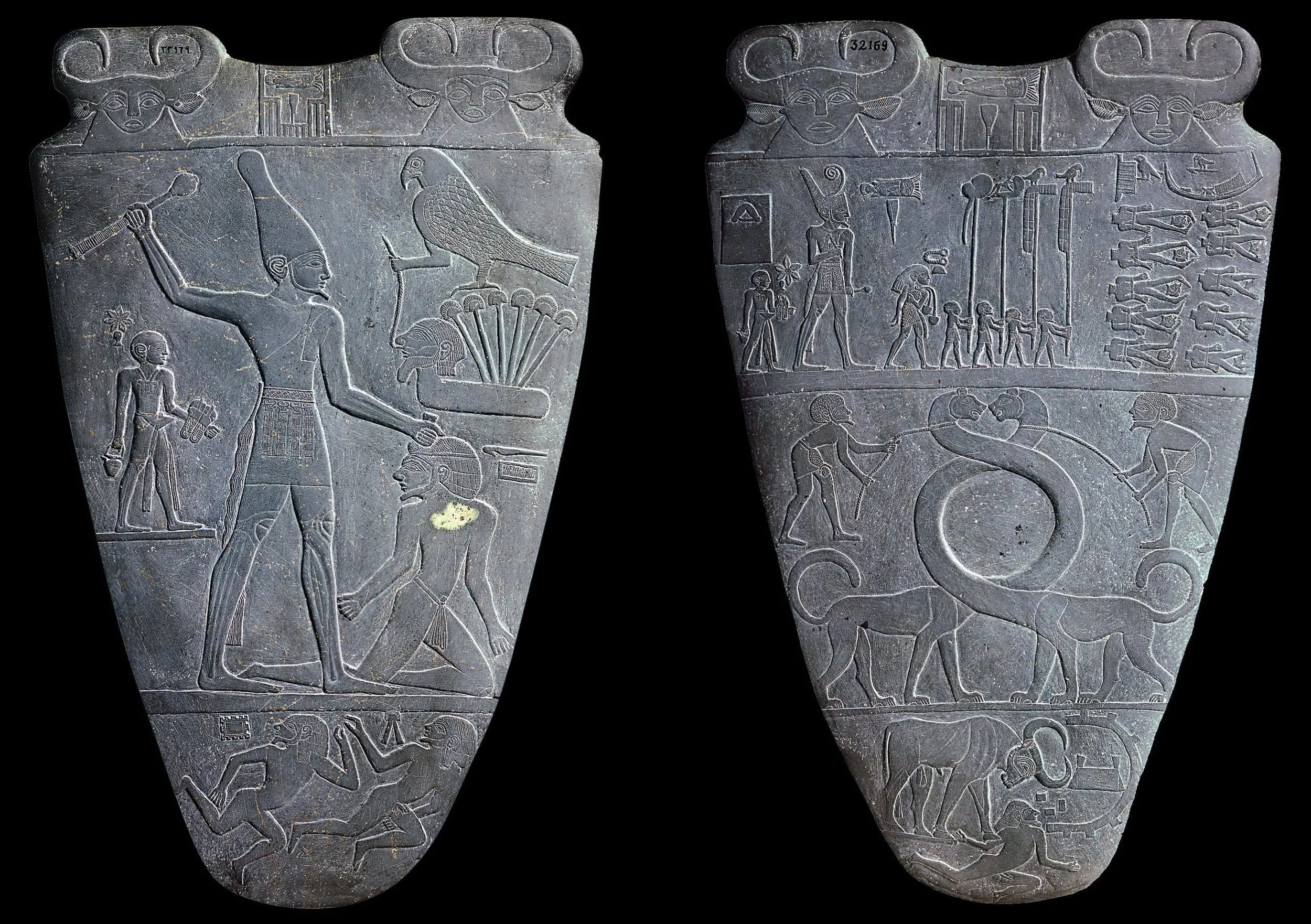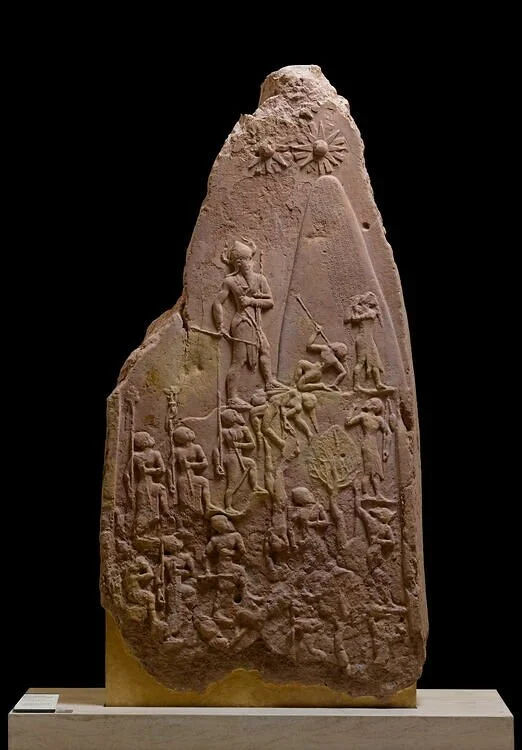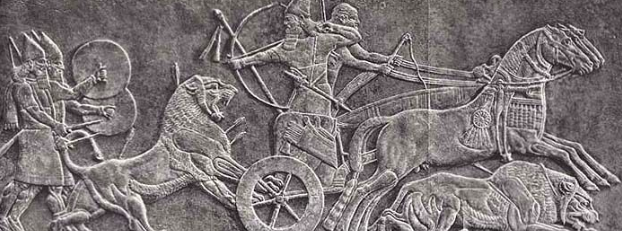Cultural Exchanges of Ancient Middle Eastern Civilizations
Cultures inherently influence one another. Immigration, trade relations, and exposure cause ripples in lifestyle, beliefs, and expression, whether conscious or not, and this can be seen throughout history. Ancient Egyptian and Near Eastern artworks and architecture are prime examples of early cultural exchanges. Along with evidence of trade relations and correspondence, related artistic conventions are easily observed.
The Ancient Near East includes multiple civilizations near the fertile crescent during 3500-334 BCE. This includes Sumer, Hittites, Nimrud, Babylon, Assyria, Akkad, Ur, Uruk, and more. Areas were often conquered and overthrown, resulting in abundant ancient empires during the millenniums. However, there was a sense of consistency due to the empires often influencing one another and the lifestyles the region's climate encouraged. The area was surrounded by multiple seas and waterways, resulting in abundant trade. During the Uruk period, the economy consisted predominantly of agriculture, manufacturing, and trade, allowing many empires to have thriving economies. Many were intelligent and made notable accomplishments, such as the early empire, Sumer's invention of writing, and the wheel.
Ancient Egypt, a civilization of unparalleled grandeur, was renowned for its robustness, wealth, and advancement. The mere mention of it conjures up images of King Tatukamens' golden funerary helmet and the Great Pyramids. From 2950-332 BCE, Ancient Egypt was a place of rich culture and monumental sculptures and reliefs. The artifacts discovered, most of which were found in tombs, provide us with a glimpse into the rich religious and ritual practices of the time. The monuments and works created during this period would challenge even modern men with modern resources. Elaborate stone sculptures were crafted with bronze tools, and massive stone structures were constructed by ordinary men.
Ancient Egypt and the Near East empires displayed impressive advancements and elaborate opulent cultures. They enhanced each other's wealth by trading precious stones, gold, and ivory. The convenience of waterways and the mutual benefits encouraged trade between empires. This trade not only fostered connections but also exposed the empires to each other's work, leading to the cultural exchange that shaped the art of these regions. The mutual influence between these empires is a testament to the interconnectedness of ancient civilizations.
At first glance, the Stele of Naram Sin (Figure 1.) and Palette of Narmer (Figure 2) have apparent similarities. Both are low-relief images using similar artistic conventions. The central figures' importance is shown through hierarchical scale, as they are at the highest point in the register and the largest element as well, which are the empire's respective kings. In the Stele, King Naram Sin is shown triumphing over his enemies with the help of his army. He holds a bow and a staff, which is displayed with his face in profile while his body is facing forward. To further emphasize Naram in this image, all other figures, including the wounded figures, look at him. The image shows the King's power and military prowess. The Palette of Narmer has similar conventions and displays power and authority in a more symbolic manner. Narmer is the largest figure at the highest point of the image, with a face in profile and his body forward. He is accompanied by the god Horus, who is presented as a falcon. The presence of the god suggests the divine power of the King as the gods support him. The piece displays King Narmer's divine power and dominance in the region, and its message is conveyed through symbolism rather than the bluntness of a war scene.
Another example of a pair of reliefs that show a cultural exchange between the Near East and Egypt is Ti Watching a Hippopotamus Hunt (Figure 3) and Assurnasirpal II Killing Lions (Figure 4). Once again, the artistic conventions of hierarchical scale and the kings have faces in profile and bodies facing forward. However, other subjects in the images are shown in a complete profile. This is especially shown in the Assurnasirpal II relief, as he is the only figure not in complete profile. Lesser subjects in the Hippopotamus Hunt are also shown with forward bodies and faces in profile. Hierarchical scale is also less prominent in the Assurnasirpal II piece, as he is barely taller than the man steering the carriage. The artistic conventions of Egypt were less of an influence on Nimrud and the Near East during the late periods.
The Lamassu and the Sphinx both represent the relationship between separate cultures. They share a common motif of a human head on an animal's body, with the Lamassu having a bull or lion body and the Sphinx having a lion's body. Both sculptures symbolize the power of the King and royal authority. The Sphinx may have also been designed to ward off evil spirits. A notable difference is the materials used to craft the pieces. The Lamassu is a double relief carved from gypsum, while the Sphinx is a statue carved from a limestone block over three years by 100 workers. There is evidence that the Sphinx was fully painted. It is clear that both civilizations used animals to represent power and superiority, and the rulers of those civilizations commissioned both pieces.
However, despite all the overlap, some similarities were coincidental. The pyramids are one of the most well-known attributes of Ancient Egypt, and Near Eastern Ziggurats could be seen as a possible influence of the pyramid. They are shaped similarly, with larger bases tapering into smaller points, whether smoothly or not. However, the differing purposes of the structures suggest otherwise. The Ziggurats are similar to pyramidal structures with temples on top and represent a meeting place between humans and the gods. The Great Pyramids of Giza were created as a part of kings' tombs and most likely evolved from the mastaba, early Egyptian burial structures.
From an architectural perspective, there may have been less direct influence between these ancient empires. This makes sense since the significance of these buildings was often tied to the religious and traditional practices of the respective regions rather than purely aesthetic considerations.
Trade has facilitated cultural exchanges throughout history, as evidenced by these empires. The influence of artistic conventions exchanged is evident in their reliefs, which, while not identical, have clear relations. The use of hierarchical scale, similar symbolism, and figure positions show a relation between the Ancient Near East and Ancient Egypt. While some similarities may be coincidental, the consistency of similar styles across these civilizations suggests that the empires influenced one another.
Figure 1: Palette of Narmer, Susa, Iran c. 3200–3000 B.C.E
Figure 2: Stele of Naram Sin, Akkadian Empire, 2254–2218 B.C.E
Figure 3:Ti Watching a Hippopotamus Hunt, Saqqara c.2450-2325 B.C.E
Figure 4: Assurnasirpal II Killing Lions, Nimrud c.875-860 B.C.E
Figure 5: The Great Pyramids of Giza, Al Haram, Egypt c. 2600 B.C.E
Figure 6: Ziggurat of Ur, Nasiriyah c. 2100 B.C.E.
SOURCES
Collen, Dominique. “Ancient Near East.” Grove Art Online, 2003. https://www.oxfordartonline.com/groveart/display/10.1093/gao/9781884446054.001.0001/oao-9781884446054-e-7000002561#oao-9781884446054-e-7000002561. Accessed October 16th, 2024
Dorman, Peter F, and John R Baines. “Ancient Egypt.” Encyclopædia Britannica, October 19, 2024. https://www.britannica.com/place/ancient-Egypt. Accessed October 16th, 2024
ETP Team. “Ancient Egyptian Trade.” Egypt Tours Portal, February 17, 2024. https://www.egypttoursportal.com/en-us/ancient-egyptian-civilization/ancient-egyptian-trade/#countries_&_partners_ancient_egyptians_traded_with.
Jarus, Owen. “Ancient Egypt: History, Dynasties, Religion and Writing.” LiveScience, June 2, 2023. https://www.livescience.com/55578-egyptian-civilization.html. Accessed October 16th, 2024
Mark, Joshua J. “Pyramid.” World History Encyclopedia, October 20, 2024. https://www.worldhistory.org/pyramid/. Accessed October 16th, 2024
Mark, Joshua. “Near East.” World History Encyclopedia, October 23, 2022. https://www.worldhistory.org/Near_East/. Accessed October 16th, 2024
McLean, John. “World Civilization.” Ancient Egyptian Trade | World Civilization. Accessed October 16th, 2024 https://courses.lumenlearning.com/suny-hccc-worldcivilization/chapter/ancient-egyptian-trade/#:~:text=Land%20Trade%20Routes&text=of%20ancient%20cities.-,Another%20route%2C%20the%20Darb%20el%2DArbain%2C%20was%20used%20from,route%20between%20Nubia%20and%20Egypt. Accessed October 17th, 2024
The Metropolitan Museum of Art. “Human-Headed Winged Lion (Lamassu): Assyrian: Neo-Assyrian.” The Metropolitan Museum of Art. Accessed October 21, 2024. https://www.metmuseum.org/art/collection/search/322609.
Munez, Everett. “Lamassu.” Encyclopædia Britannica, September 30, 2022. https://www.britannica.com/topic/lamassu. Accessed October 16th, 2024
T. Editors of Encyclopaedia., Britannica. “Ziggurat.” Encyclopædia Britannica, September 16, 2024. https://www.britannica.com/technology/ziggurat. Accessed October 17th, 2024
Tikkanen, Amy. “Great Sphinx of Giza.” Encyclopædia Britannica, September 13, 2024. https://www.britannica.com/topic/Great-Sphinx. Accessed October 17th, 2024
Written by Red Jordanger
Written October 16th, 2024
Electronically Published November 29th, 2024






